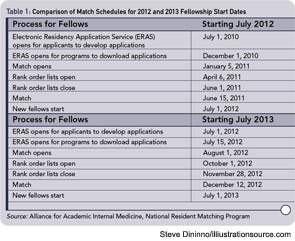
It’s no secret that there will likely be a shortage of rheumatologists in the United States in the coming years. However, that may start to change once the subspecialty match dates for fellowships move, which will be effective for fellows starting in July 2013.
The date changes give residents applying for fellowships additional time to explore potential subspecialties and apply for fellowships. Beginning with students applying for July 2013 fellowships, the application process will start July 1, 2012, which will be most applicants’ post-graduate year 3 (PGY-3). Under the current system, residents begin subspecialty and fellowship choices and applications during PGY-2 (see Table 1 for the full schedule). With the new dates, fellowships usually will start six months after a match has been made, versus 18 to 20 months under the current system. Also, with the new dates, residents will have the chance to participate in approximately 10 rotations within various subspecialties.
The change in timing was prompted as early as 10 years ago by concerns from residency program directors that residents were not always sure which subspecialty they wanted to pursue, says Anne R. Bass, MD, associate professor of clinical medicine at Weill Cornell Medical College and rheumatology fellowship program director at the Hospital for Special Surgery in New York City. Dr. Bass is a member of the ACR Workforce and Training Committee who attended meetings regarding the Subspecialty Match date changes.
“A fair percentage of people make up their mind in residency regarding their subspecialty,” says Sharon Kolasinski, MD, associate professor of clinical medicine, interim division chief, chief of clinical services, and director of the rheumatology fellowship program at the University of Pennsylvania School of Medicine in Philadelphia. Dr. Kolasinski was lead author of a study asking rheumatology fellows why they chose rheumatology.1 “If there is no exposure to rheumatology in that time, they are unlikely to get it in their internship year, when there is a pretty inflexible curriculum.”

Additionally, the letters of recommendation written for fellowship applicants do not always contain enough valuable information because faculty may not have known students for that long a time, Dr. Bass says. Internships often expose students to intensive care, oncology, and other fields, while exposure to fields with rarer diseases is less common, Dr. Bass says. “A case of bad lupus is not seen as often as a myocardial infarction,” she says. By expanding the time that applicants have to select their subspecialty, there is a chance to expose a wider scope of students to rheumatology.
The Alliance for Academic Internal Medicine and the fellowships participating in the Medical Specialties Matching Program (MSMP) voted to move the match date, and all subspecialties had to agree to the change. MSMP subspecialty societies who endorsed the change in dates included the ACR, the American Society of Hematology, Infectious Diseases Society of America, and the Association of Pulmonary and Critical Care Medicine Program Directors.
Benefiting Rheumatology
The key benefit of the match date change for rheumatology is attracting more people to the field. “I think this will expand the number of people in rheumatology who see the exciting things that we do,” says Abby Abelson, MD, chair of rheumatology at the Cleveland Clinic and chair of the ACR Workforce and Training Committee. The earlier and more frequent exposure to rheumatology may even help some students get a jumpstart on related research, Dr. Abelson adds.
“This enables residents to get more exposure with a variety of rotations before they decide which fellowship they will apply for,” she notes.
The greater exposure to rheumatology may help more people see the intellectual stimulation the field provides, Dr. Kolasinski says. “The number-one reason people in the study said they chose rheumatology was because of the intellectual interest of the field,” she says of her research on subspecialty choice. “The fellows liked the detective work and being the ultimate diagnostician. You’re putting pieces of the puzzle together, and you’re called in when others are not sure what’s going on.”
The date change will also help those already in rheumatology get a sense of the talent that is out there, Dr. Kolasinski says. “There’s a question of being exposed to students and residents and them being exposed to us and understanding that this is a career choice,” she notes.
A later match date also enables faculty to get to know applicants better, thus providing higher-quality letters of recommendation, says Dr. Bass. This is important considering that subspecialty faculty often write the most in-depth letters of recommendation for subspecialty fellowship applicants.
“The letters we’ll get will be much more helpful. Now, it’s harder for people to know interns well if they don’t have any exposure to rheumatology,” Dr. Abelson says.
There is also the hope—in all subspecialties, not just rheumatology—that the date change will help applicants feel more confident about their subspecialty choice, rather than applying for a fellowship even if they are unsure about their selection. Sometimes the indecision leads potential applicants to postpone their training for a year.
The change in timing should have no effect on trainees obtaining H1-B or J-1 visas. Additionally, the match timing should still allow applicants to apply for state licenses, even in California, which has a longer licensure lead time, Dr. Bass says.
There may be an initial transition phase for academic programs to get accustomed to the change in dates, Dr. Kolasinski says. Otherwise, she does not see many disadvantages to the change.
The date change also ensures that rheumatologists will have a busy November, between the ACR Annual Scientific Meeting and the interviews and other match-related work that will take place during that month, Dr. Abelson says.
“It couldn’t be a busier time, but we stand to benefit greatly from this,” Dr. Bass stresses.
Vanessa Caceres is a freelance medical writer in Bradenton, Florida.


